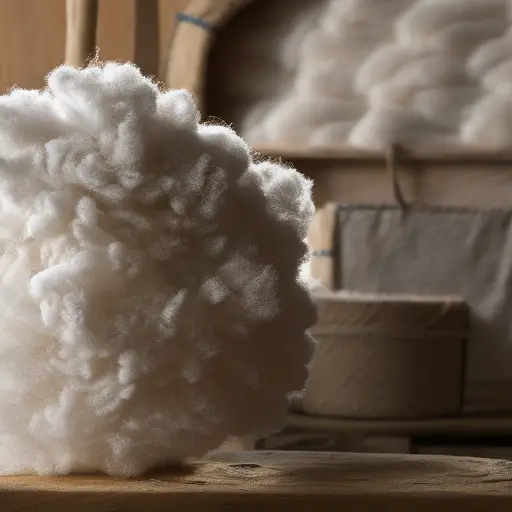Crafting Natural Insulation for Cold Environments

Did you know that proper insulation can reduce heating costs by up to 50% in cold environments?
In this article, we will explore the art of crafting natural insulation materials for cold climates.
From understanding the benefits of natural insulation to choosing the right materials for your home, we will provide you with practical tips and techniques.
Whether you are a homeowner or a contractor, this guide will help you create an energy-efficient and sustainable environment that keeps the cold at bay.
Understanding Natural Insulation Materials
To effectively utilize natural insulation materials in cold environments, it is crucial to have a comprehensive understanding of their properties and characteristics. Natural insulation materials, such as wool, cotton, cellulose, and hemp, offer numerous benefits that make them an attractive choice for homeowners.
One of the main advantages of natural insulation materials is their ability to effectively regulate temperature and moisture levels. They have excellent thermal resistance, preventing heat loss during the winter months and reducing the need for excessive heating. Additionally, natural insulation materials are breathable, allowing moisture to escape and preventing the growth of mold and mildew.
When comparing natural insulation to synthetic insulation, several key differences arise. Natural insulation materials are renewable and sustainable, making them more environmentally friendly than their synthetic counterparts. They are also biodegradable, reducing waste and ecological impact. Furthermore, natural insulation materials have a lower carbon footprint as they require less energy to produce compared to synthetic materials. Additionally, they are non-toxic and do not release harmful chemicals into the air, improving indoor air quality.
In the subsequent section, we will delve into the process of choosing the right natural insulation for your home, considering factors such as the climate, budget, and specific insulation needs.
Choosing the Right Natural Insulation for Your Home
When selecting natural insulation for your home in cold environments, it is important to consider various factors such as the climate, budget, and specific insulation needs. Natural insulation offers several benefits over synthetic options, making it an ideal choice for environmentally conscious homeowners.
Here are some factors to consider when choosing natural insulation materials:
-
R-value: The R-value measures the insulation’s thermal resistance. It is important to select a natural insulation material with a high R-value to ensure maximum heat retention in your home during cold weather.
-
Sustainability: Natural insulation materials, such as sheep’s wool, cotton, and cellulose, are renewable and biodegradable. They have a lower environmental impact compared to synthetic options, which are typically made from non-renewable resources.
-
Moisture resistance: It is crucial to choose a natural insulation material that is resistant to moisture. Materials like hemp and flax have natural moisture-wicking properties, preventing the growth of mold and mildew.
Preparing and Processing Natural Insulation Materials
Natural insulation materials require careful preparation and processing to ensure optimal performance in cold environments. The processing techniques used for natural insulation materials vary depending on the type of material being used. It is important to select materials that are sustainably sourced to minimize environmental impact. Here are some common natural insulation materials and their processing techniques:
| Material | Processing Technique |
|---|---|
| Sheep’s Wool | Shearing, cleaning, carding |
| Hemp Fiber | Retting, decortication, carding |
| Cork | Harvesting, grinding, compressing |
| Straw | Cutting, baling, bundling |
| Recycled Denim | Shredding, blending, carding |
Sheep’s wool, for example, is processed by shearing the wool from the sheep, cleaning it to remove impurities, and then carding it to align the fibers. Hemp fiber goes through a process called retting, where the outer bark is removed, and then it undergoes decortication to extract the fibers. Cork is harvested from the bark of cork oak trees, ground into small particles, and then compressed to form insulation boards. Straw is cut, baled, and bundled together to create straw bale insulation. Recycled denim insulation is made by shredding used denim, blending it with other natural fibers, and then carding it to create a uniform material.
Once the natural insulation materials have been prepared and processed, it is time to install them in walls and ceilings.
Installing Natural Insulation in Walls and Ceilings
The installation of natural insulation in walls and ceilings requires careful placement and secure attachment. When installing natural insulation, there are several steps to follow to ensure proper installation and maximize its benefits over traditional insulation methods.
Here is a step-by-step guide to installing natural insulation in walls and ceilings:
-
Prepare the surface: Before installing natural insulation, make sure the walls and ceilings are clean and free from any debris or moisture. This will help ensure a secure and long-lasting installation.
-
Measure and cut the insulation: Measure the area where the insulation will be installed and cut the natural insulation material to fit. It is important to leave a small gap around the edges to allow for expansion.
-
Secure the insulation: Attach the natural insulation to the walls and ceilings using nails, staples, or adhesive. Make sure the insulation is tightly secured and there are no gaps or loose areas.
Maintaining and Repairing Natural Insulation
To ensure the longevity and effectiveness of natural insulation in walls and ceilings, regular maintenance and timely repairs are essential. Maintaining natural insulation involves taking proactive measures to prevent damage and ensuring that the insulation continues to perform optimally. This can include regular inspections, cleaning, and addressing any issues that may arise.
When it comes to repairing insulation damage, it is important to identify the cause of the damage and address it promptly. Whether it is due to moisture, pests, or wear and tear, repairing the insulation will help maintain its efficiency and prevent further issues.
To assist in understanding the maintenance and repair process, the following table provides an overview of common maintenance tasks and repair techniques for natural insulation:
| Maintenance Task | Description | Repair Technique | Description |
|---|---|---|---|
| Insulation Inspection | Regularly inspect insulation for any signs | Patching | Repair small holes or tears in the insulation |
| of damage or deterioration. | |||
| Cleaning | Remove dust, debris, or any foreign | Replacement | Replace damaged insulation with new material |
| materials that may reduce insulation | |||
| Pest Control | Address any pest infestations that may | Reinforcement | Strengthen weakened areas of insulation |
| damage or compromise the insulation. | |||
| Moisture Management | Identify and address any sources of | Moisture barrier | Install a moisture barrier to prevent |
| moisture that may impact the insulation. | installation | moisture damage |
Exploring Alternative Natural Insulation Techniques
When it comes to exploring alternative natural insulation techniques, there are a few key points to consider.
One is the use of innovative insulation materials, such as recycled denim or cellulose made from newspaper. These materials not only provide effective insulation but also reduce waste and environmental impact.
Another point to explore is the availability of eco-friendly insulation options, such as sheep’s wool or cork, which are renewable and biodegradable.
Innovative Insulation Materials
Exploring alternative natural insulation techniques involves investigating innovative materials for effective insulation in cold environments. Here are three innovative insulation materials that offer sustainable insulation solutions and provide numerous benefits of natural insulation:
-
Cork: Cork is a renewable and sustainable material that offers excellent thermal insulation properties. It is derived from the bark of cork oak trees and is known for its low conductivity and high resistance to moisture. Cork insulation is not only environmentally friendly but also provides soundproofing benefits.
-
Sheep’s Wool: Sheep’s wool is a natural and biodegradable material that offers excellent insulation properties. It is known for its ability to regulate moisture, absorb pollutants, and provide effective thermal insulation. Sheep’s wool insulation is also fire-resistant and has a long lifespan.
-
Hempcrete: Hempcrete is a mixture of hemp fibers and a lime-based binder. This innovative material offers excellent insulation properties, including high thermal resistance and breathability. Hempcrete is a sustainable alternative to traditional insulation materials, as hemp grows quickly and requires minimal water and pesticides.
Eco-Friendly Insulation Options
Continuing the exploration of innovative insulation materials, eco-friendly insulation options offer sustainable and effective solutions for insulation in cold environments.
These sustainable insulation solutions not only help reduce energy consumption but also have a minimal impact on the environment. One of the most popular natural insulation techniques is using recycled materials such as recycled denim, newspaper, or cellulose fibers. These materials are treated with fire-retardant chemicals to ensure safety.
Another option is sheep’s wool, which is not only a renewable resource but also has excellent thermal insulation properties. Additionally, natural materials like hemp, flax, and cork can be used as insulation, providing both thermal and acoustic benefits.
These natural insulation options offer numerous benefits, including improved energy efficiency, reduced environmental impact, and increased indoor comfort.
Frequently Asked Questions
What Are the Advantages of Using Natural Insulation Materials Over Synthetic Ones?
Natural insulation materials offer several advantages over synthetic ones. They are environmentally friendly, non-toxic, and sustainable. They also have excellent thermal performance, moisture control, and sound absorption properties, making them ideal for cold environments.
Are There Any Specific Natural Insulation Materials That Are More Effective in Extremely Cold Environments?
Are there natural insulation materials that excel in extreme cold? Sustainable alternatives offer renewable insulation options that effectively retain heat and resist cold temperatures, providing a practical solution for cold environments.
Can Natural Insulation Materials Be Used in Both New Construction and Retrofitting Existing Homes?
Using natural insulation materials for energy efficiency in commercial buildings and the cost effectiveness of natural insulation materials in residential construction can be achieved through both new construction and retrofitting existing homes.
Are There Any Special Considerations or Precautions to Take When Installing Natural Insulation in Walls and Ceilings?
When installing natural insulation in walls and ceilings, it is important to consider factors such as moisture control, proper ventilation, and ensuring a tight seal. Precautions should be taken to avoid gaps, mold growth, and compromised insulation effectiveness.
How Long Can Natural Insulation Materials Be Expected to Last Before Needing to Be Replaced?
The longevity of natural insulation materials and their maintenance requirements vary depending on factors such as material type, installation quality, and environmental conditions. Regular inspections and maintenance can prolong the lifespan of natural insulation, minimizing the need for replacement.
Conclusion
In conclusion, natural insulation materials offer a sustainable and environmentally friendly alternative for cold environments. By understanding and choosing the right materials, preparing and processing them correctly, and installing them in walls and ceilings, homeowners can effectively insulate their homes while reducing energy consumption.
Additionally, maintaining and repairing natural insulation ensures its longevity and efficiency. An interesting statistic to note is that homes insulated with natural materials can reduce energy usage by up to 50%, leading to significant cost savings and a smaller carbon footprint.





